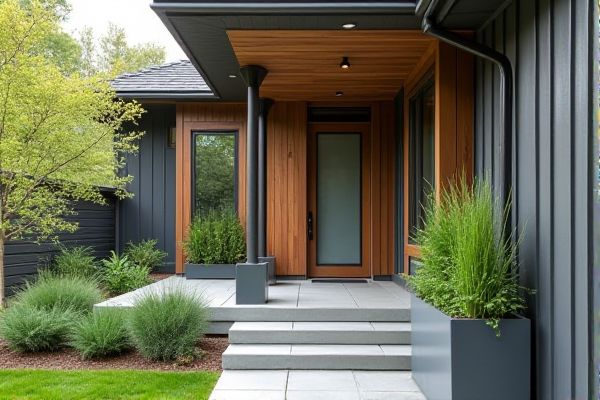
Built-in planters provide a seamless, integrated look for your porch and often require less maintenance compared to standalone planters, which offer flexibility and easy relocation to suit changing design preferences. Explore the rest of the article to discover which planter option best fits your porch style and gardening needs.
Table of Comparison
| Feature | Built-In Planter | Standalone Planter (Porch) |
|---|---|---|
| Installation | Integrated into existing structure | Freestanding, no structural modification needed |
| Space Efficiency | Maximizes use of porch edges or walls | Requires additional floor space |
| Mobility | Fixed, non-movable | Portable and repositionable |
| Design Flexibility | Limited by porch design and materials | Wide variety of styles and materials |
| Cost | Higher due to custom installation | Generally lower, ready-made options available |
| Drainage | Built-in drainage solutions | Depends on standalone design and self-management |
| Maintenance | Requires structural upkeep | Easier to clean and maintain |
Overview: Comparing Built-In vs Standalone Porch Planters
Built-in porch planters offer seamless integration with your porch architecture, providing enhanced stability and a cohesive aesthetic that often increases property value. Standalone planters provide flexibility in arrangement and easy mobility, allowing you to change your porch design or seasonal plantings without structural modifications. Your choice depends on whether you prioritize permanent design harmony or versatile, customizable gardening options.
Aesthetic Appeal and Design Flexibility
Built-in planters seamlessly integrate into porch architecture, creating a cohesive and polished aesthetic that enhances your outdoor space's overall design harmony. Standalone planters offer greater design flexibility, allowing you to easily rearrange, replace, or experiment with various styles and plant arrangements to suit evolving tastes. Choosing between the two depends on whether you prioritize a permanent, streamlined look or adaptable, personalized decor.
Space Efficiency and Porch Layout Optimization
Built-in planters offer superior space efficiency by seamlessly integrating into your porch structure, freeing up floor area for walking or furniture placement. Standalone planters provide flexibility in porch layout, allowing you to rearrange or replace them to suit changing design preferences or seasonal needs. Your choice between these options can significantly impact the functional flow and aesthetic of your porch space.
Installation Process: Built-In vs Standalone
Built-in planters require precise measurements and integration into your porch structure, often involving professional installation to ensure durability and proper drainage. Standalone planters offer a simpler setup, allowing you to place and move them easily without structural modifications. Your choice affects installation time and flexibility, with built-in planters providing a permanent, customized solution and standalone options delivering convenience and adaptability.
Maintenance and Longevity Considerations
Built-in planters typically offer enhanced durability due to integrated construction with the porch, often utilizing weather-resistant materials that reduce maintenance frequency. Standalone planters, while easier to move and replace, may require more regular upkeep, such as sealing or repainting, to withstand exposure to outdoor elements. Proper drainage in both types is essential to prevent root rot and prolong the lifespan of plants, but built-in planters often provide better drainage systems, contributing to longer-term plant health and structural integrity.
Plant Variety and Growing Conditions
Built-in planters offer a controlled environment ideal for cultivating specific plant varieties that require stable soil conditions and consistent moisture levels, making them perfect for herbs, succulents, or seasonal flowers. Standalone planters provide flexibility to move your plants according to changing sunlight patterns and microclimates on your porch, allowing you to accommodate a wider range of species with diverse growing requirements. Your choice depends on whether you prioritize precise control over growing conditions or the ability to adjust placement for optimal plant health and variety.
Cost Analysis: Initial Investment and Upkeep
Built-in planters generally require a higher initial investment due to construction and integration with porch design, but they offer long-term durability and lower maintenance costs. Standalone planters are more cost-effective upfront, providing flexibility and easy replacement, though they may require more frequent upkeep and potential weather-related wear. Your choice depends on balancing budget constraints with preferred longevity and maintenance commitment.
Mobility and Seasonal Adaptability
Built-in planters offer stability and integration with the porch structure but lack mobility, making seasonal repositioning difficult. Standalone planters provide flexibility, allowing easy relocation to optimize sunlight exposure and protect plants from harsh weather throughout different seasons. Mobility in standalone planters supports better plant health and adaptability by facilitating timely adjustments to changing environmental conditions.
Impact on Property Value and Curb Appeal
Built-in planters enhance property value by integrating seamlessly with architectural design, creating a polished and cohesive look that appeals to potential buyers. Standalone planters offer versatility and easy updates but may lack the permanent aesthetic impact that elevates curb appeal. Homes featuring built-in planters typically experience higher marketability and perceived maintenance quality, positively influencing resale values.
Choosing the Right Planter for Your Porch
Built-in planters offer seamless integration with your porch design, providing durability and a cohesive aesthetic that enhances the overall structure. Standalone planters deliver flexibility in placement and style, allowing for easy rearrangement and seasonal changes in your porch decor. Selecting the right planter depends on your porch architecture, desired maintenance level, and personal preference for versatility versus permanence.
 homyna.com
homyna.com